Advertisements
Advertisements
Question
3 mole of a gas at temperature 400 K expands isothermally from an initial volume of 4 litres to a final volume of 8 litres. Find the work done by the gas. (R = 8.31 J mol-1 K-1)
Solution
Given:
n = 3 mol, T = 400 K, Vi = 4 L, Vf = 8 L, R = 8.31 J mol-1 K-1
To find: Work done by gas (W)
Formula: `"W"_"isothermal"` = nRT In`"V"_"f"/"V"_"i"`
Calculation:
From formula (i),
W = 3 × 8.31 × 400 × In`(8/4)`
Now, ln x = 2.303 × log (x)
∴ In`(8/4)` = ln (2) = 2.303 log (2)
∴ W = 1200 × 8.31 × 2.303 × 0.3010
= antilog{log(1200) + log(8.31) + log (2.303) + log(0.3010)}
= antilog{3.0792 + 0.9196 + 0.3623 + (`overline1`.4786 )}
= antilog{3.8397}
= 6.913 × 103 J
= 6.913 kJ
Work done by the gas is 6.913 kJ.
APPEARS IN
RELATED QUESTIONS
A thermodynamic system is taken from an original state to an intermediate state by the linear process shown in Figure

Its volume is then reduced to the original value from E to F by an isobaric process. Calculate the total work done by the gas from D to E to F
Answer in brief.
Why should a Carnot cycle have two isothermal two adiabatic processes?
What is a thermodynamic process?
Draw a p-V diagram of the irreversible process.
Draw a p-V diagram showing positive work with varying pressure.
Explain the thermodynamics of the isochoric process.
When food is cooked in a vessel by keeping the lid closed, after some time the steam pushes the lid outward. By considering the steam as a thermodynamic system, then in the cooking process
When you exercise in the morning, by considering your body as a thermodynamic system, which of the following is true?
Apply first law for an adiabatic process.
Draw the PV diagram for the isothermal process.
Can the given heat energy be completely converted to work in a cyclic process? If not, when can the heat can completely converted to work?
Explain the isobaric process and derive the work done in this process.
Explain in detail the isochoric process.
What are the limitations of the first law of thermodynamics?
For a given ideal gas 6 × 105 J heat energy is supplied and the volume of gas is increased from 4 m3 to 6 m3 at atmospheric pressure. Calculate
- the work done by the gas
- change in internal energy of the gas
- graph this process in PV and TV diagram
A monoatomic gas of pressure p having volume V expands isothermally to a volume 2V and then adiabatically to a volume 16V. The final pressure of the gas is ____________.
`("ratio of specific heats" = 5/3)`
Two identical samples of a gas are allowed to expand (i) isothermally (ii) adiabatically. Work done is ____________.
In an isothermal process, the volume of an ideal gas is halved. One can say that ____________.
Ideal gas for which 'ϒ' = 1.5 is suddenly compressed to `1/4`th of its initial volume. The ratio of 4 the final pressure to the initial pressure is ______.
`(ϒ = "C"_"p"/"C"_"v")`
Consider P-V diagram for an ideal gas shown in figure.
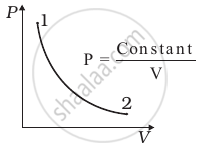
Out of the following diagrams (figure), which represents the T-P diagram?
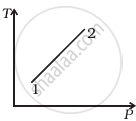 (i) |
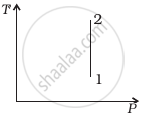 (ii) |
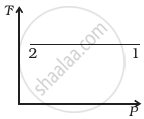 (iii) |
 (iv) |
In the figure shown here, the work done in the process ACBA is ______.
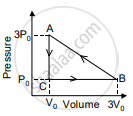
In a certain thermodynamical process, the pressure of a gas depends on its volume as kV3. The work done when the temperature changes from 100°C to 300°C will be ______ nR, where n denotes number of moles of a gas.
Explain how can a gas be expanded at constant temperature.
In a cyclic process, if ΔU = internal energy, W = work done, Q = Heat supplied then ______.
